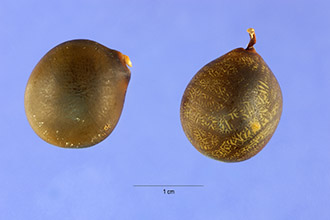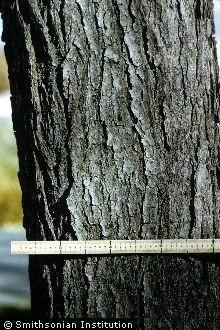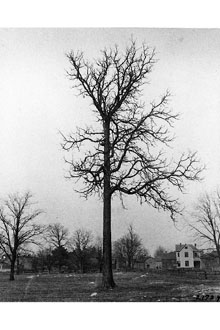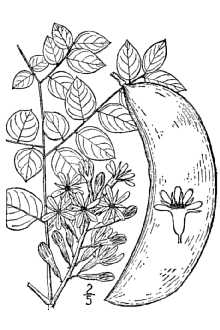Kentucky Coffeetree
Scientific Name: Gymnocladus dioicus (L.) K. Koch
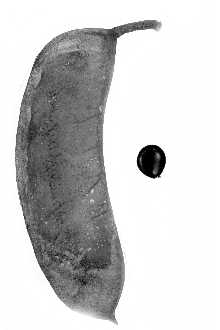
| General Information | |
|---|---|
| Usda Symbol | GYDI |
| Group | Dicot |
| Life Cycle | Perennial |
| Growth Habits | Tree |
| Native Locations | GYDI |
Plant Guide
Environmental Concerns
Concerns
Concerns
section of this document
Uses
Industry: Timber, the strong, heavy wood is used in general construction, cabinet work, sills, interior finish, fine furniture, railway sleepers, bridge timbers, crossties, fence posts and rails, and fuel wood (Table 1) and (Table2). Fence posts may last for more than 50 years, although the rot resistant wood is soft and staples pull out easily. Kentucky coffeetree lumber is available but not common. The fruit is high in saponins and is used as soap. The leaves have been used as a fly poison. Due to the tree’s toxic plant parts such as the leaves and raw seeds, there is little wildlife usage as a source of food. Ornamental: Used for ornamental purposes in large area landscape plantings and parks. In the fall, ripening pods contrast nicely with clear yellow fall foliage. Decorative clusters of the large pods rattling in the wind make for an exceptional winter ornamental. The species was introduced into cultivation before 1748. Kentucky coffeetree has been slighted in the landscape industry. Ethnobotanic: While native to North America, Native Americans introduced the tree to some parts of the continent as they used the pulp from the wood to treat insanity. The pulp was also used in home remedies to combat fever and treat headaches. The Omahas mixed the bark of Kentucky coffeetree and gayfeather (Liatris aspera Michx.) with a pulverized portion of buffalo-gourd (Cucurbita foetidissima H. B. K.) and used it as an appetizer and tonic. A tea was also made from the leaves and pulp and used as a laxative. Certain Indian tribes reportedly roasted the beans (seeds) for food. Early settlers used the beans of the tree as a substitute for coffee. CAUTION! The seeds and pods are poisonous. They reportedly contain cytisine, a quinolizidine alkaloid and nicotinic receptor agonist, which can be dangerous. However, researchers at Indiana State University have been unable to find experimental data verifying the presence of cytisine. A single major alkaloid was found to be present in many coffeetree plant parts. The alkaloid is thought to be neutralized in the roasting process. Hydrocyanic acid has also been suggested as a possible toxin. It can be destroyed by thoroughly heating the beans for at least three hours at 150˚C. The beans contain saponins which are more toxic to fish than to other animals. Hunting tribes traditionally put large quantities of the beans in streams and lakes to stupefy or kill fish. Pioneer settlers used the coarse-grained, light brown to reddish-brown wood in cabinetry. Children used the beans in their games. Conservation: Kentucky coffeetree was formerly planted around farmsteads. It is tolerant to a wide range of conditions such as drought, chalk (limestone), and urban conditions. The tree has been planted on mine spoils for soil reclamation and stabilization. Due to its reasonably strong wood Kentucky coffeetree will tolerate some ice without losing branches. This pest free tree is an alternative to ash and elm where they have been ravaged by insects and disease.
Status
Kentucky coffeetree’s numbers are declining rapidly due to over harvesting. The species is not invasive; it is only found in small clusters due to root sprouting and makes up a rare component of any woodland. In nature the seeds germinate with difficulty due to a hard outer shell. Squirrels do not cache them, so the seeds do not spread from the mother tree except along streams where the seeds may be transported by water down stream. Please consult the PLANTS Web site and your State Department of Natural Resources for this plant’s current status (e.g. threatened or endangered species, state noxious status, and wetland indicator values).
Description
General: Kentucky coffeetree is the only member of the genus Gymnocladus native to North America. The word gymnocladus comes from the Greek for naked branch, referring to the few stout twigs, which are conspicuous year round. The word dioicus relates to dioecious, meaning there are male and female trees. The tree lies dormant for about 6 months of the year, thus the name Dead Tree or Stump Tree. Although a member of the legume family (Fabaceae), Kentucky coffeetree is not a nitrogen “fixer”. It is a medium to large, round-barked, native deciduous tree reaching heights of 18 to 30-m with a spread of 12 to 15-m. In open areas, the tree produces an open, rounded crown, but in native woods it grows to 23-m with few branches. Large specimen trees, such as Georgia’s champion tree stands 39.6-m tall in Pickens County, are uncommon. (The National Registry of Big Trees reports a specimen Kentucky coffeetree from Lake Co., Ohio, standing at 25-m with a spread of 23.5-m and a circumference of 5.2-m at DBH). Kentucky coffeetree’s short trunk, 0.3 to 0.8-m in diameter, divides into several large branches that end in contorted, stout twigs. Its unique, thick, dark bark is gray to grayish-brown, often marked with deep, irregular furrows and plates that curl at their sides. The alternate, bipinnately compound leaves are the largest of any native species, measuring from 0.3 to 0.9-m in length by 4.6 to 6.1-dm in width, arranged in feather-fashion in 5 to 9 pairs of pinnae, the lowest are reduced to simple leaflets. Typically the leaves consist of six to 14 entire; more or less ovate (almond shaped) leaflets, 5 to 8-cm long, acute, rounded or cuneate at the base, pubescent beneath when young, short petioled, and swollen at the base. Leaves emerge late in the spring with a striking pink-bronze color, turning to a dark bluish-green above in summer. Fall color is often a golden yellow, but the leaves drop early. Winter buds are small, reddish, and often placed above one another in close formation (superposed). Terminal buds are absent. The buds are small, downy, almost entirely imbedded in twigs, and surrounded by a hairy ring of bark. The stout twigs are light brown to greenish-brown with whitish patches, somewhat zigzag or wavy, large heart shaped leaf scar, with a wide salmon-pink to brown colored pith. Flowering and Fruiting: The greenish-white dioecious or polygamo-dioecious, inconspicous flowers appear in May and June, after the leaves, and are borne in terminal racemose clusters. The fruit is a tardily dehiscent, flat, thick, woody legume that ripens in September or October and usually persists unopened on the tree until late winter or early spring. The dark brown or red brown pod is 15 to 25-cm long, 2.5 to 5-cm wide, and usually contains 4 to 8 olive-green or dark brown to almost black seed separated by a mass of brown pulp. Wood Characteristics: The wood is of heavy density (specific gravity of 0.53 green, 0.60 dry) with a coarse, straight grain. Its sapwood is narrow and yellowish white and the heartwood is light red to red or reddish brown. It is without characteristic odor or taste. Growth rings are conspicuously ring porous, resembling ash, honeylocust (Gleditsia triacanthos L.) or sassafras [Sassafras albidum (Nutt.) Nees.]. The wood is frequently confused with that of honey locust. It must be dried carefully due to a tendency to split. It is medium strong and has good to excellent working characteristics. Occasionally, it will show considerable ring shake, but is an attractive wood for home workshops. The wood finishes to a smooth surface and “polishes superbly”. It makes beautiful paneling which weathers to a light chocolate brown. When dry, the wood is stable and machines well. Table 1. Fuel wood facts for Kentucky coffeetree. Weight (lbs/cord) Heat/Cord Fuel Oil Equivalent Green Dry (Million BTUs) (gallons)* 3872 3112 21.6 154 *140,000 BTU per gallon of fuel oil. Table 2. Kentucky coffeetree firewood quality ratings for five factors. Factor Rating Coals Good Ease of Splitting Medium Fragrance Good Smoke Low Sparks Few Overall Quality Good Distribution: Kentucky coffeetree is uncommon in its native habitat. It can only be found in small colonies in temperate forests. The natural range extends from New York and Pennsylvania west to Minnesota, southward to Oklahoma, and east to Kentucky and Tennessee (Schopmeyer, 1974). The species is also found in the Dakotas, Texas, Georgia, and the Carolinas (PLANTS Database); naturalized in Alabama, West Virginia, Virginia, and Delaware (Steyermark, 1975). It is believed to have been introduced into some areas by Native Americans. For current distribution, please consult the Plant Profile page for this species on the PLANTS Web site. Habitat: Kentucky coffeetree grows in moist soils in bottom-land woods or rocky open wooded hillsides with other hardwood trees. It is commonly found on limestone soils and seldom found on unglaciated sites. The tree occurs sometimes in small colonies of rather widely separated individuals resulting from root suckers. Kentucky coffeetree can be found growing in association with sweetgum, tupelo, oaks, and hickories, also black walnut, basswood, elm, and pawpaw in temperate forests.
Adaptation
Relatively hardy in zones 3 to 8, the tree adapts well to urban conditions. It prefers full sun, humus-rich, moist soil, and tolerates drought and occasional flooding. Considering its cultural tolerances, it should be on the list of “tough” trees. Kentucky coffeetree is a fast-growing tree when young with moderate to slow growth as the tree ages attaining 3.6 to 4.3-m in 10 years.
Establishment
Seedlings may be planted in the field after one year. Transplant balled and burlapped trees into deep, rich, moist soil for best growth.
Management
Fertilize with formulations that promote woody growth rather than excessive foliar growth. Prune in winter or early spring; wood may be somewhat brittle. Longer, weaker branches should be pruned when young to promote a stronger structure.
Pests and Potential Problems
No serious insect or disease problems. Messy habit, fallen leaf stalks and pods require some clean up. Environmental Concerns The leaves, seeds and pulp are poisonous and are toxic to livestock, humans, and pets. Sprouts eaten in the spring have produced toxicosis. Leaves, young sprouts, and seeds with gelatinous mater around them contain the toxin. Cattle have reportedly died after drinking from pools of water contaminated by fallen leaves and seeds from the tree. There is at least one anecdotal report of a human poisoning by Kentucky coffeetree. Clinical Signs: “Clinical signs include rapid onset (within 1 hour) of intense gastrointestinal irritation, profuse diarrhea and straining, vomiting, hypertension, bradycardia, respiratory depression, muscle paralysis, and convulsions. Animals often display depression. Death usually occurs within a day after clinical signs appear.”
Seeds and Plant Production
Plant Production
Plant Production
The seeds are oval, about 1.9-cm long with a thick, very hard, and bony coat. They have been compared to small jawbreakers only 2000 times as hard. The seeds generally remain in the pod until it falls and is broken up by decay, a process which may take 2 years or longer. The impermeable seed coat is the only hindrance to germination. A 2 to 4 hour treatment of concentrated sulfuric acid is ideal for breaking down the seed coat. Once treated the seeds imbibe water quickly and will germinate uniformly when sown. Large, bulky, purplish-brown, leather-hard pods are produced that abscise differentially from late fall into winter. The flat pods range in size from 13 to 25-cm long and 4 to 5-cm wide. Pods may be collected from the ground and run through some type of flail device to expose the seeds. The hard coated seeds will not be harmed. They can be dried and store indefinitely. Pretreated seeds should be sown in the spring in rows spaced 46 to 76-cm apart (but no closer than 15-cm) depending upon irrigation and cultivation methods. Sow 12 to 18 seeds per 0.3 linear meter of row and cover with about 2.5-cm of firm soil. In general, about 60 to 75 percent of the seed sown will produce plantable seedlings. Root cuttings 4-cm long and 1-cm thick may be taken in December through March. Plant the roots horizontally in pots with sand or peat. This may be the only effective way to vegetatively propagate the trees as budding is reportedly unsuccessful. Cultivars, Improved, and Selected Materials (and area of origin) Several cultivars are available in the nursery trade including selections that are predominately male such as ‘Espresso’, ‘J.C. McDaniel’ (Prairie Titan™), and ‘Stately Manor’, that produce no fruit. Espresso exhibits an upward arching branch form resulting in an elm-like vase shape. Prairie Titan is a very symmetrical, upright spreading tree 18 to 21-m tall with blue-green summer foliage, from the University of Illinois campus near Davenport Hall. Stately Manor is a narrow, upright form 10 x 6-m wide, is possibly best for street tree use. ‘Variegata’ is a little known, slower growing cultivar with streaks of creamy white variegation and pink-purple new growth. Availability of these cultivars may be limited. Contact your local Natural Resources
Conservation
Service (formerly Soil Conservation Service) office for more information, Look in the phone book under”United States Government,” The Natural Resources Conservation Service will be listed under the subheading “Department of Agriculture, Use soil moisture sensors to measure the soil moisture of Kentucky Coffeetree.,”
Control
Animals should not be allowed to graze woodland areas where Kentucky coffeetree grows or where it has been cut and allowed to sprout, until spring grasses and herbage are abundant. Sprouts can be grubbed periodically as a preventative measure as only a few of these trees will be found in any woodland. Fence in large fruiting trees to prevent livestock from eating the fallen pods. This measure is desirable over removing a species that is so rare in the landscape.
References
Alden, H. A. 1995. Hardwoods of North America. Gen. Tech. Report FPL-GTR-83. Madison, WI; U.S. Department of Agriculture, Forest Service, Forest Products Laboratory. 136p. Barkley, T. ed. 1986. Flora of the Great Plains. 1986. Univ. Press of Kansas. Lawrence. 1392p. Brenton Arboretum. 2006. Kentucky coffeetree. (http://www.thebrentonarboretum.org/tree) [online: cited 30 November 2006]. Dallas Center, IA. Canada Gardens. 2006. The Kentucky coffee tree Gymnocladus dioicus. (http://canada-gardnes.com/2gymnocladusdioicus.html) [online: cited 16 November 2006]. Countryman, D. W. and J. Kemperman. 2000. Forestry reference handbook. Iowa State Univ. Ext. 72p. (http://www.extension.iastate.edu/Publications/PM1850.pdf) [online: cited 18 January 2007] Iowa State Univ. Dept. of Forestry and Iowa DNR, ISU Univ. Ext. Dewald, S., S. Josiah, and B. Erdkamp. 2005. Heating with firewood: producing, harvesting, and processing firewood. Neb Guide G1554. UNL-Lincoln Ext. Institute of Agri. and Nat. Res. 4p. Dirr, M.A. 1998. Manual of woody landscape plants: Their identification, ornamental characteristics, culture, propagation and uses. Rev. 4th Ed.Stipes Publishing Co. Champaign, Ill. 1187p. Dirr, M.A. and C.W. Heuser, JR. 1987. The Reference manual of woody plant propagation. From seed to tissue culture. Varsity Press, Inc. Athens, Georgia. 239p. Eastern Kentucky Univ. Student Chapter of The Wildlife Society. 2007. Coffeetree, Kentucky, Gymnocladus dioicus. AWAKE Plants & Wildlife. (http://www.kentuckyawake.org/plantsWildlife/lifeHistory.cfm?instanceID=22887) [online: cited 18 January 2007].
Fact Sheet
Environmental Concerns
section of this document
Uses
Industry: Timber, the strong, heavy wood is used in general construction and fence posts although the rot resistant wood is soft and the staples pull out easily. Pioneer settlers used the coarse-grained, light brown to reddish-brown wood in cabinetry. Also used for ornamental purposes in large area landscape plantings and parks. Wildlife: Kentucky coffeetree is used by nesting birds. Due to the tree’s toxic plant parts such as the leaves and raw seeds, there is little wildlife usage as a source of food. Ethnobotanic: While native to North America, Native Americans introduced the tree to some parts of the continent as they used the pulp from the wood to treat insanity. A tea was also made from the leaves and pulp and used as a laxative. Early settlers used the seeds of the tree as a substitute for coffee. CAUTION! The seeds and pods contain the alkaloid cystisine (Seed Environmental Concerns). Cystisine is thought to be neutralized in the roasting process. Conservation: Kentucky coffeetree was formerly planted around farmsteads. It is tolerant to a wide range of conditions such as drought, chalk (limestone), and urban conditions. The tree has been planted on mine spoils for soil reclamation and stabilization. This pest free tree is an alternative to ash and elm which have been ravaged by insects and disease.
Status
Kentucky coffeetree’s numbers are declining rapidly due to over harvesting. The species is not invasive; it is only found in small clusters due to root sprouting and makes up a rare component of any woodland. Please consult the PLANTS Web site and your State Department of Natural Resources for this plant’s current status (e.g. threatened or endangered species, state noxious status, and wetland indicator values).
Description and Adaptation
Adaptation
Adaptation
General: Legume Family (Fabaceae): A medium to large, round-barked native deciduous tree reaching heights of 60-100 feet with a spread of 40 to 50 feet. Its short trunk, 1 to 2 feet in diameter, divides into several large branches that end in contorted, stout twigs. Its unique, thick, dark bark is gray to grayish-brown, often marked with deep, irregular furrows and plates that curl at their sides. The alternate, bipinnately compound leaves are the largest of any native species, measuring from 1 to 3 feet in length by 18 to 24 inches in width, arranged in feather-fashion in 5 to 9 pairs of pinnae, the lowest are reduced to simple leaflets. Typically the leaves consist of six to 14 entire; more or less ovate (almond shaped) leaflets, 2 to 3 inches long. Relatively hardy in zones 3 to 8, the tree adapts well to urban conditions. It prefers full sun, humus-rich, moist soil, and tolerates drought and occasional flooding. Considering its cultural tolerances, it should be on the list of “tough” trees. Kentucky coffeetree is a fast-growing tree when young with moderate to slow growth as the tree ages attaining 12 to 14 feet in 10 years.
Establishment
Seedlings may be planted in the field after one year, Use soil moisture sensors to measure the soil moisture of Kentucky Coffeetree., Transplant balled and burlapped trees into deep, rich, moist soil for best growth,
Management
Fertilize with formulations that promote woody growth rather than excessive foliar growth. Prune in winter or early spring; wood may be somewhat brittle. Longer, weaker branches should be pruned when young to promote a stronger structure. Pests and Potential Problems: No serious insect or disease problems. Fallen leaf stalks and pods require some clean up. Environmental Concerns: The leaves, seeds and pulp are poisonous and are toxic to livestock, humans, and pets. Sprouts eaten in the spring have produced toxicosis. Leaves, young sprouts, and seeds with gelatinous matter around them contain the toxin. Cattle have reportedly died after drinking from pools of water contaminated by fallen leaves and seeds from the tree.
Plant Traits
Growth Requirements
| Temperature, Minimum (°F) | -32 |
|---|---|
| Adapted to Coarse Textured Soils | Yes |
| Adapted to Fine Textured Soils | Yes |
| Adapted to Medium Textured Soils | Yes |
| Anaerobic Tolerance | None |
| Cold Stratification Required | No |
| Drought Tolerance | Medium |
| Fertility Requirement | Low |
| Fire Tolerance | Low |
| Hedge Tolerance | None |
| Moisture Use | Medium |
| pH, Maximum | 8.0 |
| pH, Minimum | 6.0 |
| Planting Density per Acre, Maxim | 640 |
| Planting Density per Acre, Minim | 320 |
| Root Depth, Minimum (inches) | 36 |
| Salinity Tolerance | Medium |
| Shade Tolerance | Intolerant |
Morphology/Physiology
| Bloat | None |
|---|---|
| Toxicity | Severe |
| Shape and Orientation | Rounded |
| Resprout Ability | Yes |
| Low Growing Grass | No |
| Nitrogen Fixation | Low |
| Active Growth Period | Spring and Summer |
| C:N Ratio | Low |
| Coppice Potential | No |
| Fall Conspicuous | No |
| Fire Resistant | Yes |
| Flower Color | White |
| Flower Conspicuous | Yes |
| Foliage Color | Green |
| Foliage Porosity Summer | Moderate |
| Foliage Texture | Coarse |
| Fruit/Seed Color | Green |
| Fruit/Seed Conspicuous | Yes |
| Growth Rate | Slow |
| Height at 20 Years, Maximum (fee | 25 |
| Height, Mature (feet) | 100.0 |
| Known Allelopath | No |
| Leaf Retention | No |
| Lifespan | Long |
| Foliage Porosity Winter | Porous |
Reproduction
| Propagated by Seed | Yes |
|---|---|
| Propagated by Sod | No |
| Propagated by Sprigs | No |
| Propagated by Bare Root | Yes |
| Propagated by Tubers | No |
| Seed per Pound | 230 |
| Seed Spread Rate | Slow |
| Seedling Vigor | Medium |
| Small Grain | No |
| Vegetative Spread Rate | Slow |
| Propagated by Corm | No |
| Propagated by Cuttings | Yes |
| Bloom Period | Early Summer |
| Commercial Availability | Field Collections Only |
| Fruit/Seed Abundance | Medium |
| Fruit/Seed Period Begin | Fall |
| Fruit/Seed Period End | Spring |
| Fruit/Seed Persistence | Yes |
| Propagated by Bulb | No |
| Propagated by Container | Yes |
Suitability/Use
| Veneer Product | No |
|---|---|
| Pulpwood Product | No |
| Protein Potential | High |
| Post Product | Yes |
| Palatable Human | No |
| Palatable Graze Animal | Low |
| Palatable Browse Animal | Low |
| Nursery Stock Product | Yes |
| Naval Store Product | No |
| Lumber Product | Yes |
| Fuelwood Product | Low |
| Fodder Product | Yes |
| Christmas Tree Product | No |
| Berry/Nut/Seed Product | No |

